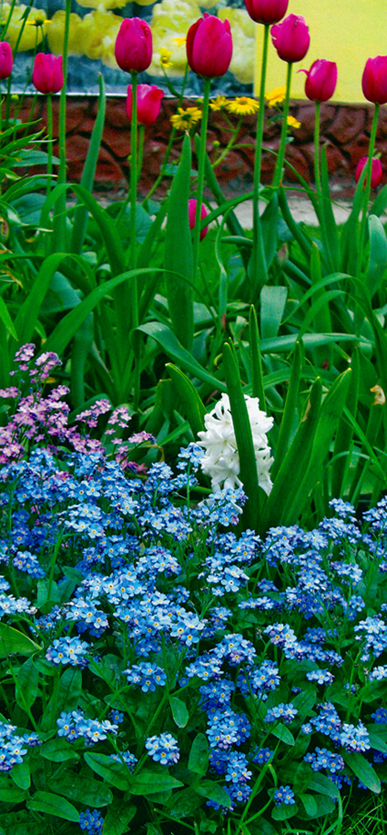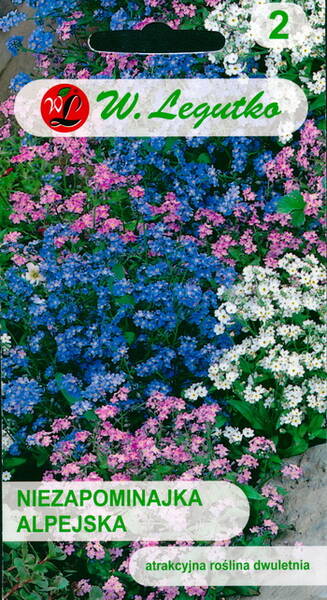A perennial plant, 20-30 cm high, cultivated as a biennial. Blooms profusely in May-June.
Numerous small flowers are white, carmine-pink and dark blue.
Prefers semi-shady areas with moist, fertile soil. Grown by sowing in the ground in May-June.
Plants are transplanted to a permanent place at the end of August or in the spring of next year. It tolerates a transplant in a flowering form.
Used for spring decoration of flower beds and balconies, for cutting.
1,0 g = 1500-2000 seeds.
GROWING IN OPEN GROUND.
According to standard technology, seeds are sown in pre-prepared beds in May - June; if young plants are covered for the winter, later sowing dates are also acceptable (until September). The soil is prepared in advance: dug up, humus, peat (up to 5 kg / m2), nitrophoska (1 tbsp. / m2) are added and leveled.
Sow in small furrows located at a distance of 10 cm from each other, or scattered over the soil surface, sprinkling with fine leaf soil (planting depth - no more than 5-6 mm).
Sufficient heat, moisture and light contribute to successful germination and more uniform seed emergence. If necessary, crops are shaded from direct sunlight. Shoots appear in 12-15 days. After 3-4 weeks (when true leaves appear), the seedlings are thinned out or planted at a distance of 5-8 cm from each other.
Further care consists of systematic watering, loosening and removing weeds.
In late August - early September or in spring (April - May), the grown plants are transplanted to a permanent place at a distance of 15-20 cm from each other. Forget-me-nots planted in this manner form a real dense carpet of leaves, and later - of white, pink and sky-blue flowers.
When growing forget-me-nots in open ground, only a rosette of leaves is formed in the 1st year, flowering occurs in the summer of the following year.
To obtain flowering plants already in the year of sowing, forget-me-nots are grown through seedlings.
GROWING THROUGH SEEDLINGS.
Depending on what time it is planned to receive finished commercial products, the timing of sowing seeds for seedlings varies. To obtain non-flowering green seedlings for subsequent planting in flower beds in May, sowing is done in late February - early March: flowering occurs in the second half of summer.
For greenhouse production of flowering seedlings for flower beds and containers, it is necessary to sow seeds in late October - November. In this case, you will receive ready-made potted plants by the end of April - early May.
Seeds are sown in the soil of a heated greenhouse or small containers with soil; a light, well-drained sterilized substrate is used (the recommended composition of the soil mixture: turf soil and river sand in a ratio of 2:1). Seeds are sown randomly, lightly sprinkled on top and strongly moistened.
At a temperature of +20..+25°C, sprouts appear within 4-6 days. After the shoots have fully emerged, the air humidity is gradually reduced, as well as the temperature - to +15..+18°C.
After the development of the first pair of true leaves, the seedlings are pricked out: 1 piece is planted in pots or cassettes with wet peat soil and left to grow. At first, the transplanted seedlings are kept at a temperature of +5..+7°C, moderately watered, and supplemented with light if necessary. When flower stems appear, the temperature is increased to +10..+12°C, watered more abundantly (but not excessively!) - during this period, it is useful to add superphosphate and potassium salt, at the rate of 15-18 and 5-8 g / m2, respectively. Ready seedlings are planted in a permanent place in late April - early May.
CARE - SIMPLE.
Forget-me-nots are completely unpretentious and undemanding to growing conditions plants, resistant to short-term frosts (up to -5 °C) and drying out of the soil. They tolerate transplanting well with a lump of earth even in a flowering state.
They bloom and develop normally in the shade, but prefer well-lit (shaded at midday) areas with loose, moderately moist and nutritious soils - beautiful bright inflorescences and fresh leaves in this case are preserved until autumn.
Soils that are too rich in organic matter, especially fertilized with fresh manure, cause active, prolonged growth of leaves to the detriment of flowering.
Forget-me-nots are easy to care for - regular loosening and watering. Due to the fact that the plants are planted quite densely, the plantings practically do not need weeding.
Lack of moisture has a negative effect on the condition, duration and intensity of flowering of plants, while excessive moisture causes them to rot or excessive stretching of stems.
A good effect on poor soils is provided by the application of organic and mineral fertilizers in May (1 teaspoon of urea, potassium sulfate and nitrophoska per 10 liters of water) at the rate of 2 l / m2.
To prevent diseases, spray with chemicals.
By promptly removing faded inflorescences, you will preserve the decorativeness of the bush, limit self-seeding and ensure longer flowering of plants.
When cold weather sets in, before snow falls, it is good to mulch the plants with peat, leaves or spruce branches. Forget-me-nots that have successfully overwintered bloom in early May. In damp, cool weather and proper care, they bloom profusely for 1.5-2 months.
Most garden forms of forget-me-nots are perennial plants, but it is recommended to grow them as annuals or biennials - older specimens often degenerate and lose their decorative properties: the stems become very elongated, the flowers become smaller.

Alpine Forget-Me-Not. Bot. syn.: Sylvatica alpestris.












